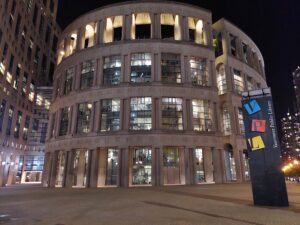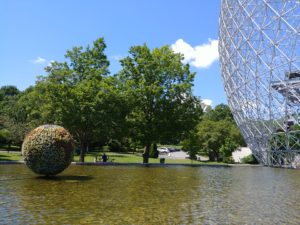By Medard Gabel Published in Kosmos Journal in the Fall | Winter 2015
Sustainable Development is a half-vast approach to vast problems. Its purpose, to make life on this planet sustainable, is a noble disguise for the maintenance of the status quo. When the status quo includes hundreds of millions of acres of degraded to destroyed farmland and leveled rainforest, depleted to exhausted fisheries and aquifers, toxic-choked streams, decreasing biodiversity, and a changing climate, sustainability is simply not acceptable. In short, sustainable development is like the bromide ‘do no evil’; it does not set the bar high enough. We can, and need, to do better than just sustain the unacceptable—or accept the present as the best we can do.
The latest improvement on sustainability is the concept of ‘zero emissions.’ Here it is not acceptable to produce just enough waste so as to not overwhelm nature’s capacity to recycle our industrial by-products. The goal is to produce our goods and services in a way that there are no wastes—so that the by-products of one industrial process become the inputs for another process. In this industrial ecology, we connect the waste streams from one industrial plant to the input channels of another, thereby turning waste into resources. This is another noble goal and a huge improvement on the basic notion of sustainability—but we can do better than zero.
Beyond Sustainability and Zero Emissions
Our local and global problems and visions for what we want need to be viewed in the context of a new problem-solving and development framework, which I call regenerative development.
Development is the use of resources to improve the wellbeing of a society. What is called sustainable development is the use of resources to improve society’s wellbeing in a way that does not destroy or undermine the support systems needed for future growth. Regenerative development is the use of resources to improve society’s wellbeing in a way that builds the capacity of the support systems needed for future growth. What sustainable development is to traditional economic development, regenerative development is to sustainable development.
To take one example: ‘sustainable agriculture’ refers to a process of producing food that does not degrade the ecosystems on which agriculture depends. It seeks to farm in ways that keep soil erosion at ‘replacement’ levels. In this way, future generations will be able to farm the same land. This is a huge improvement over traditional, soil-erosion intensive farming, but does not go far enough. It is now technologically possible and economically competitive to produce food while simultaneously leaving the plot of land better off—to farm in ways that not only leave roughly the same amount of soil after harvest, but actually to increase the quantity and quality of soil after harvest—that is, to farm regeneratively. Regeneration builds capacity; sustainability, at best, maintains it.
Regeneration can work across all development sectors — not just in agriculture. Every problem confronting global society can be approached through the regeneration model. The question in sustainable development is “How can we solve this problem in such a way that we sustain or do not hurt the underlying support systems?” The question in regenerative development is “How can we solve this problem in such a way that we improve the capacity of the underlying support systems?” How can we meet our needs and develop our economy in ways that result in more rainforests, more fertile soils, restocked fisheries, clean and abundant aquifers and streams, a cleaner atmosphere, and even more biodiversity?1 After we have met our needs for basic life support and the additional goods and services that modern society identifies with the myriad and evolving definitions of the ‘good life’—how do we do all that in ways that make our life supporting infrastructure stronger, more resilient and diverse, deeper and more alive than it was before we showed up? That is the challenge facing humanity in the 21st century, not how do we preserve what remains of our dwindling stocks of ecosystem infrastructure.
Regenerative development seeks to increase the efficiency and capacity of our industrial and technological metabolism while providing life-support services and products for the world’s population. Like zero emissions sustainability, it seeks to close all the open loops spewing waste into the environment and direct these valuable resources to places in the industrial metabolic system where they can become valued inputs. The goal is to reduce waste and close valves that allow valuable chemistries to flow out of the industrial system into natural systems, where they become known as ‘pollution.’ But regenerative development goes further.

Principles of Regenerative Development
There are key interlinked principles that structure regenerative development. The most important are outlined below.
The whole world is now the only relevant unit of problem solving
Globalization has, whether we like it or not, made us all one. We have always been voyaging on one ship, the SS Earth, but globalization has transformed this philosophy into an economic, technological, political, and ecological reality that is unavoidable, no matter how high the walls on our gated community or how far removed from the centers of civilization we choose or are forced to live.
A global approach is not altruism, some noble gesture by the rich to help out the less fortunate; it is a self-serving, pragmatic economic investment. It is not much of a leap to see the enormous implications of adding an additional three to four billion consumers to the global economy. In a regenerative system, when these new ‘middle class’ people leave poverty behind and join the global economy, they don’t deplete the world’s capacity, they add to it.
Moreover, the most cost-effective solutions are now global ones. For example, it makes no sense to try to eliminate deadly or debilitating diseases from just the US or Europe if we do not also eliminate them from the rest of the world. The economics (to say nothing of the ethics) are compelling: for example, since smallpox has been eradicated from North America and Western Europe, those regions have saved over $5 billion on what they were spending each year on smallpox control within their borders (vaccination, border monitoring, etc.) More than 40 million cases of smallpox in the world have been avoided since its eradication.2 If each of these cases caused a mere $1,000 in economic loss, that translates into a savings of $40 billion to the global economy—more than 130 times the original investment of $300 million.3 A global approach will produce cost-effective solutions to all our basic problems of human need, environmental threats, and security—not just disease eradication.
Another example of self-interest is even closer to home: It is not too difficult, in a post-9/11 world, to point out to Americans and other citizens of wealthy nations the advantages of a world free of the festering poverty that underlies resentment towards conspicuous consumption in a world of haves, have-nots, and have-no-hopes. On a fundamental level, as the desperately poor get their needs met, the entire world becomes more secure, stable, and safe for everyone. Wealth is a function not only of how much you have, but also of where you have it. If you have $10 billion of gold bullion on a sinking luxury liner, you are just going to sink faster. Making the world work for 100% of humanity means that wherever we are and no matter how rich we are today, we will then be even ‘richer’—more secure, safe, and in an almost infinitely more rich and stimulating cultural environment.
The long term is the framework in which we must operate
A short temporal focus is analogous to a small spatial focus: both are ineffectual, costly, counter-productive, and more than likely destructive to the wellbeing of the whole system. Whether that system is your body and the short-term focus your fondness for fatty foods and the couch near the TV, or society’s fixation on political platitudes like “no child left behind” that provide an illusion of educational reform—the short term is often at odds with the wellbeing of the whole over the long term. Investments in renewable energy, affordable health care, and universal education are positive examples of how a view to the long term can help out in the short term. This is not to say that a concern with next quarter’s profit is foolish, only that next quarter needs to be in tune with the next ten to twenty years. The larger the temporal frame of reference, the more possibilities there are and the deeper is our understanding of the past and its implications for the future.
In addition, looking at the world through the long-term lens makes prevention, rather than treatment or cure, the logical and most economical option. For example, a focus on the short term led the US to provide $4 million a year in aid to boost agricultural productivity in Ethiopia. In 2003, when crops failed and famine threatened, the US was compelled to send in $500 million in emergency food aid.4 Another example of a short-range, ‘least-cost’ strategy that backfired was the US approach to dealing with AIDS in Africa. The US provided about $50 million a year to Africa for AIDS prevention in the 1990s. By 2004, with over 20 million dead and another 30 million infected, the US is now spending $3 billion per year to treat the disease.5
Everyone is needed
The old way dictated that to build a bridge you needed an engineer. Building a bridge today, we need the engineer but also the people who are going to use that bridge; those who are going to build it, manufacture the parts, and obtain the raw materials; the ecologists who will tell us where it can be placed so that it does the least damage to the environment; and most important, the citizens who will decide if they want the bridge in the first place and who will pay for it, in one way or another.
This is not neo-liberal do-gooder public policy rhetoric; it is pragmatic, cost-effective essentials for regenerative development. The day of the ‘expert’ is over. Or more precisely, the day of the technological expert riding roughshod over culture, ecology, and values is over. Everyone is an expert on what they want and know.
The table needs to include all stakeholders or the capacity building that is critical to any endeavor will not reach its potential. A corollary of this principle is that the nation state is no longer the only major player on the global stage. Global corporations, cities, nations, NGOs, and private citizens all need to work together on getting what the world wants.
If the ‘problem’ being addressed is to be solved (and stay solved), decision making at the local level and input from all sectors of local society are needed. This provides learning and growth opportunities for the larger system of which the problem is a part. Every development strategy is an opportunity to increase the knowledge and capacity of the society in which development is occurring.
Everybody wins
Regenerative development is not a win/lose economic strategy. Neither is it what is called a win/win strategy. This implies a two-party dynamic and there are always more than two players or stakeholders in any problem of global scale. Getting what the world wants is a win/win/win solution. Or more accurately, it is a winning solution. A successful strategy will have at least national, local, corporate, environmental, economic, and global winners. And a successful strategy will ripple through all those systems, helping resolve other problems or eliminating the causes of them—as adequate nutrition eliminates many health care problems caused by lack of food, and adequate health care increases the productivity of economic systems as workers are absent less from work due to illness, and renewable and clean supplies of energy lessen the global buildup of carbon in the atmosphere and global warming.
Another aspect of the ‘everybody wins’ principle is that overall trends of general economic improvement (“GWP is growing at 3% per year;” “the economy is booming!” etc.) are only a first-order indicator of economic health. These macro indicators need to be seen in the context of local microeconomic health indicators. If social indicators of wealth go up but there are pockets of poverty where these trends do not hold, we are all impoverished—just as your heart, brain, and nervous system might be in great shape but if there is a cancerous growth in your lungs, you are not healthy at all.
Transparency is key
All government processes, decisions, and actions, as well as business practices, industrial processes, environmental impacts, and accounting of ingredients, waste, and costs must be subject to open disclosure and public access. Transparency in decision-making and problem solving will go further toward getting what the world wants more than any number of laws.6 When everyone knows the budget numbers it’s hard to hide corruption. And because they are so important to the capacity and wellbeing of the world, this principle must also apply to intergovernmental, nongovernmental, and religious organizations and their activities, funding, and accounting.
Capacity, not problems, must be our focus
We must transform the art and science of problem solving into building capacity. We need to see ‘problems’ not as something that needs to be ‘solved,’ but as a symptom of something larger— the need to enlarge the capacity of a system. Another way of looking at this is to say that we need to focus on creating wealth, not just reducing poverty. When we focus on building capacity, it becomes apparent that wealth is in the whole, not the parts.
Example 1: If the ‘problem’ is that someone is hungry, the conventional ‘solution’ is to get that person some food. Through building capacity, you expand the system’s ability to provide food and the hungry person’s ability to obtain it.
Example 2: The problem is a shortage of electric energy in a city. The standard solution is to build another large power plant. In capacity building, however, we look at the entire energy system and the regional and national systems of which it is a part and see how they could be made more efficient, resilient, reliable, safe, and affordable. The emphasis is on how to build up the energy system’s capacity and ‘health,’ not just its output. Demand as well as supply is a part of the system. Improvements in production and distribution efficiency, lowering of demand, decentralized or distributed production, and more efficient end-users are all part of the capacity-building equation. The end result might be the same—in this case, electricity for more people in the city—but the system with more overall capacity is stronger than one with just an additional power plant.
Example 3: The problem is not enough sales. The ‘solution’ is to knock on more doors to get more sales. A regenerative development approach would expand the capacity of the system to get more sales—go on the Internet, market to other countries, try to improve the product you are trying to sell, and examine the needs of the system you are selling in for ways to expand its capacity. Building capacity focuses efforts on the context of so-called problems; it helps us to understand challenge by understanding the system it fits into. By expanding capacity, we deal with the conditions that give rise to the problem—instead of treating symptoms.
General systems theory pioneer Ross Ashby provided another view on this in his law of requisite variety, which states that a system, in order to survive, must be designed to have a greater capacity for change than the processes of the environment that affect it.
The world’s needs are actually potential markets
In a corollary to the capacity-building principle, what we see as ‘problems’ are markets awaiting the enterprising entrepreneur who can figure out how to meet those needs. Problems are unmet needs that can often be met through creative products matched to the real needs of real people. Meeting the basic human needs of people in emerging markets requires that the product and its marketing and financing be creative and well-thought-out. Creative, even radical, marketing techniques—often in a tri-sector partnership with local NGOs and government—are as important as brilliant products.
In a world where the world’s needs and problems are perceived as markets, the market economy becomes a tool for regenerative solutions. In this context, poverty is a mandate for entrepreneurial innovation and creativity, not just government intervention and paternalistic imposition of top down ‘solutions.’ Moving towards an inclusive capitalism system such as this strengthens the entire global economy. Using market forces wherever possible helps ensure that ‘solutions’ don’t arrive stillborn or disappear as soon as outside funding dries up. It is becoming increasingly clear that profitability is essential for at least economic sustainability; that profit provides the incentive needed for the kinds of effort and investment needed to make solutions successful. The need to make a profit forces solutions to be products and services that are valued by customers and which customers will pay for and, not incidentally, puts the customer in charge, rather than a government bureaucracy. Becoming informed, active, and involved consumers—and voting with their currency, local communities invest their valuable resources in projects that benefit their families and in which they have a stake in making sure they stay viable. The poor are transformed from victims into consumers—and when informed consumers are in charge, a market place is one of the better tools for ensuring power and control is in the hands of the community.
“I am enthusiastic over humanity’s extraordinary and sometimes very timely ingenuities. If you are in a shipwreck and all the boats are gone, a piano top buoyant enough to keep you afloat that comes along makes a fortuitous life preserver. But this is not to say that the best way to design a life preserver is in the form of a piano top. I think that we are clinging to a great many piano tops in accepting yesterday’s fortuitous contrivings as constituting the only means for solving a given problem.”
—Buckminster Fuller, Operating Manual for Spaceship Earth

Design replaces politics
If politics is the art of the possible, design is the art of making the impossible real. That is, design sees what is needed, not what is just expedient or politically easy and figures out how to make it happen. It starts with a vision of what is needed, not what is popular. ‘Design science,’ as Buckminster Fuller called it, would seek to find or design an artifact that solved a problem or built the capacity of a system in such a way that the source of the problem was eliminated. Fuller’s unique contribution was in seeing design as a way around the power structure. Instead of fighting it in a bloody revolution to more ‘fairly’ redistribute the world’s wealth, he saw that a design revolution could make the poor as wealthy as the richest person through providing better-designed artifacts for living.7 Fuller also pointed out the radical concept that the designer needed to consider all of humanity as the client, not just the person with the most economic wherewithal.
More with less must be the design ethic
Getting ever-higher performance out of every gram of material and erg of energy invested in every function performed by our human-made life-support is critical to making the world’s limited resources meet the needs of our growing population and to reducing our impact on our environment. Fuller pointed out that the sum total of the world’s technology was operating at around 4% efficiency.8 More up-to-date analysis has put the efficiency of the US economy at around 6%.9 By raising the efficiency of how we manufacture, use, and dispose of our products, we could raise the overall efficiency of our technological lifesupport systems four-fold.10 Many products can be made five, ten, even one hundred times more efficient in their use of materials and energy.11

Biology replaces mechanics
The models we use shape the way we see the world and our reality. Using mechanistic models for problems has led the world to mechanistic solutions—solutions that fail when one of the cogs in the machine fails, that are seen as ‘independent’ of their environment, and that regularly create as many new problems as old ones they solve. Viewing the world as a living system fosters a respect for a problem’s complexity, an awareness of the context or environment in which it is embedded, and the possible solutions that can result in strengthening the health of the system and the elimination of the problem.
Viewing our technology as a collection of independent machines, each composed of myriad parts, none of which are related, all of which somehow add up to a life-support system for humanity is, in the end, a debilitating and lifeless view of technology and our role in creating that technology. Seeing our technological systems as living systems, interrelated and interdependent as the various systems and components of our own bodies and their environment, even going so far as to see technology as biology, leads to a whole new perspective on everything from the historical developments (embryology) of technology, possible options that mimic nature and living systems (biomimicry), to current and future trends (teleology), and even for the philosophically minded, humanity’s role in the universe (cosmology).
Seeing our collective life-support system as an external metabolic system, analogous to but more differentiated than our individual life-support system we refer to as our internal metabolic system helps us realize the interrelatedness of all our technology, its multiple functions in society, and its vital role in maintaining our viability as a species. Most importantly, given the present state of our ignorance about our environmental interactions, it helps us to see the vital connections between our living systems and our environment. Viewing our technology as an external metabolic system, the healthy functioning of which is essential for humanity’s health and wellbeing, makes the notion of ‘zero emissions’ not just a utopian fantasy or environmental platitude but as important as stopping the internal bleeding of a wound to an individual human being.
Using biological models leads to the use of biological or ecosystem-based management tools. Such big picture management helps put the value of our environmental resources in a context that illustrates their true value. It leads to the reversal of management priorities—putting the value of the environment first and the target of exploitation (fish, food, forest, minerals), second.12 In information short or uncertain circumstances, it provides a logic for erring on the side of caution when setting production quotas or targets. It also helps shift the burden of proof so that economic production does not take place unless it can be shown that it does not harm or lower the value of the environment.
“There is nothing so useless as doing efficiently that which should not be done at all.”
—Peter Drucker
Development, not growth is our goal
We need to transform society, not just enlarge it. As Russell Ackoff succinctly put it, “Growth is an increase in size or number. Development is an increase in competence, the ability to satisfy one’s needs and desires and those of others. Growth is a matter of earning; development is a matter of learning. Development is not a matter of how much one has but how much one can do with whatever one has.”13 The implications of this are profound, not the least of which is that if development is a matter of learning, then one cannot do it for another.
Scalability is essential
If a solution to a problem or a product or service for a market cannot be scaled up from the prototype stage to wide-spread adoption and use, it is stillborn. A brilliant local solution that doesn’t scale up is only half complete. The job of regenerative development is to move good solutions from local prototype or proof of concept to full-scale global implementation. Scalability works both ways: the discipline of looking to scale enriches the prototype by making it more universal, robust, and adaptable.
“Economics is applied ethics.”
—Reverend Jesse Jackson
Vision drives action. Money follows vision
The ideal—what we want—trumps what politicians think is practicable, expedient, or currently affordable. Society’s goals (the ‘preferred state’) are determined by what we want, not what we are afraid of; this is a statement of values and a definition of health. Regenerative development’s long-term and global perspectives focus on building capacity as a way of realizing our dreams, rather than solving problems as a way of avoiding our nightmares.
Creating an ideal future is a powerful tool for integrating multiple stakeholders into a cooperative team working together on making real what they want. It allows people to let go of tightly held positions and valued turf as the vision of the greater win replaces the meager holdings of the problem-laden, present-day situation. Brought together, their joint capacities enlarged, the participants—even the more cynical or pessimistic—can see within reach an ideal that once seemed far-fetched.
Regenerative development uses an ideal vision of the future to organize the resources needed to achieve it. The vision needs to be grounded in present-day technological feasibility—no “we’ll get our energy from fusion” or “we’ll dispose of our pollution on the moon” fantasies. The regenerative development approach is grounded in real world capabilities and informed by a pragmatic vision of what is desired.
Summary
The principles of regenerative development construct a frame of reference for looking at the world—at our problems, resources, and options—in a way that can lead to a future of ecosystem health, economic wealth, and human prosperity. It is a ‘big picture’ framework for design, planning, and action that will solve our global problems in ways that not only respect the Earth and its life-support systems, but that enhance them, ensuring that the next generation’s world is richer in every way than ours.
Regenerative development is characterized by a global and longterm perspective and approach that builds our capacity for qualitative growth. It values and needs input from all stakeholders; is transparent so that everyone can see how they win and what they might need to give up to gain a greater good; sees problems and needs as markets for social and economic entrepreneurs; and utilizes design that relies on doing more with less to accomplish its ends. It is focused on the vision of what is desired, not what is expedient. Driven by that vision of the ideal, rather than reacting to what is thought possible given current limitations, regenerative development is in tune with nature, with what the world wants, and with the resources and technology that can take us there.
Note: This article is reprinted from a paper by Medard Gabel ©2005 with stylistic edits by Kosmos.
References
1 Bioengineering and genetic engineering are here to stay. Focusing them on restoring lost species, rather than cloning new “Frankensteins,” is a more regenerative path for this science. Incentives need to be established for this use of genetic engineering.
2 “Death Throes of a Crippler,” New York Times, May 27, 2003.
3 WHO, Removing Obstacles to Healthy Development (Geneva, WHO, 1999, p. 29). 4 Jeffrey Sachs, “Doing the sums on Africa,” ( The Economist, May 22, 2004, p.19). 5 Ibid.
6 Ann Florini, “ The End of Secrecy.” Foreign Policy, Summer, 1998. p.50.
7 M. Gabel. “Buckminster Fuller and the Game of the World” in Buckminster Fuller: Anthology for the new millennium (New York. St, Martin’s Press, 2001). For a more thorough explication of Fuller’s design methodology, see: B. Fuller, “Universal Requirements for a Dwelling Advantage” in No more second hand God (Southern Illinois University Press, 1962) and B. Fuller, “Design Science Event Flow” in Utopia or Oblivion (New York, Bantam Books, 1968).
8 Buckminster Fuller, Utopia or oblivion, (New York, Bantam Books, 1968).
9 Paul Hawken, Amory Lovins, Hunter Lovins, Natural capitalism (New York, Little, Brown, 1999, p.14). 6% of the vast flows of materials in the US economy end up as products.
10 E. von Weizsacker et al.; Factor Four: Doubling Wealth, Halving Resource Use (Earthscan, London, 1996).
11 Paul Hawken, Amory Lovins, Hunter Lovins, Natural capitalism, (New York, Little, Brown, 1999. p. 12).
12 E. K. Pilitch et. al. “Ecosystem-Based fishery Management,” (Science, July 16, 2004, p. 346).
13 Russell Ackoff, “Transforming the Systems Movement,” May 26, 2004.

















